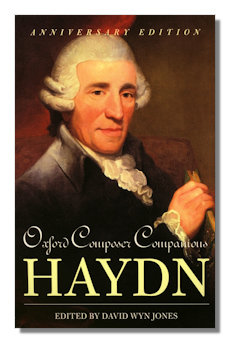
The Internet's Premier Classical Music Source
Related Links
-
Introduction
Acoustics
Ballet
Biographies
Chamber Music
Composers & Composition
Conducting
Criticism & Commentary
Discographies & CD Guides
Fiction
History
Humor
Illustrations & Photos
Instrumental
Lieder
Music Appreciation
Music Education
Music Industry
Music and the Mind
Opera
Orchestration
Reference Works
Scores
Thematic Indices
Theory & Analysis
Vocal Technique
Search Amazon
Recommended Links
Site News
 Book Review
Book Review
Haydn

Oxford Composer Companions
David Wyn Jones, Ed.
Oxford University Press. 2009. xxi + 515 pp.
ISBN-10: 0199554528
ISBN-13: 978-0199554522
The Oxford Composer Companions are bywords for quality and reliability. David Wyn Jones, professor of music and Head of the Music School at Cardiff University in Wales since 2008, is a specialist in music of the Classical period and in that of Haydn in particular. His expertise, status in that field and editorial acumen guarantee a book of equally high caliber. It's no surprise, then, that Oxford Composer Companions – Haydn must be considered as the standard reference work on the composer. No work of this kind is ever definitive: new scholarship brings updated facts and refined interpretations continually. But for this anniversary year, which has seen so much to celebrate for lovers of Franz Joseph Haydn, this is the place to come for details, background, context and even for evaluation of the man, his life, times and world.
Originally published in 2002, the book under consideration here has been reissued this year in paperback specifically to co-incide with and support the Haydn bicentennial. It's very reasonably priced given its over 500 pages, ease of use, and the fact that no fewer than 41 musicians, academics, writers and performers contributed the one thousand entries which the book comprises. In addition there are family trees, maps and appendices listing all Haydn's works and incipits, cross-referenced to the Hoboken catalog.
Entries are indexed thematically at the front of the book in lieu of an index as such – since its substance is itself an encyclopedia. These themes include: Haydn's biography and background; aristocratic and royal families; other composers; family and friends; impresarios, performers and publishers; geographical information; religious and other artistic movements; Haydn's music's reception; his music itself… genres; structure and style; entries on the individual works; nicknames; annotations; instruments and performance practice; and (subsequent) scholarship, influence, publications and technical terms.
Some entries are brief – usually those elucidating a misattribution or alternative name and minor figures. Others run to many pages – on the quartet, Haydn recordings, the keyboard sonata. These contain references and annotations in their own right and usually (though not always: Sonata form doesn't) switch from two column to one column format as befits the density and extensiveness of the essay. The entries, although grouped by theme conceptually (and under the structure of the aforementioned thematic index) are arranged entirely alphabetically. Most, though not all, entries are credited to a contributor. Deciding how to allocate these 1,000 amongst 40+ busy people on three continents, and still produce a splendid balance of consistency with style is testament by itself to the extent to which the scale of the undertaking has succeeded.
Criteria of success for such a book as the Haydn are three: comprehensiveness, accuracy and currency. On all three counts (as well as on impeccable levels of layout, appearance and accessibility etc) it scores perfectly. The book also serves as a reminder of just how global was Haydn's reach and achievement. That is, as you read entries as your mood or will takes you, you'll be struck by just how great a figure he was merely by the legitimacy and relevance of so many of the terms (such as sonata and quartet), people (from princes to Brahms), places and institutions (from Oxford to Bratislava) and contemporary events and trends (from the French Revolution to the "sublime") in their bearing on understanding Haydn. In other words, the compendious whole is more than the sum of the Haydn's parts: Haydn's reputation is indeed still developing. His milieu was amazingly rich and deep. To have grouped so clearly and transparently in one place information that reflects this depth and richness contributes greatly to our understanding of his place in serious music.
It could be said that there is perhaps a dearth of images in Haydn. This is more than made up for by the sheer readability, conciseness and thoroughness of the wealth of material, which is so meticulously written, edited and presented. It seems hard to imagine anyone from scholar to casual listener and lover of Haydn in particular, and music in general – so central was he to the music which came after him – who could not benefit from using this book. Those who need up-to-date reliable factual and interpretative sources, with the layout and disposition of which they need to become comfortable and familiar, are equally well served by the scope and feel of this book. Recommended without reserve.
Copyright © 2009 by Mark Sealey


















